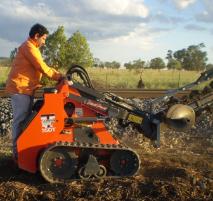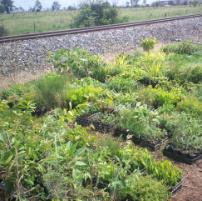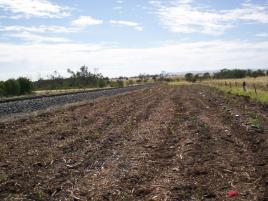Native plants chosen for rail track stabilisation
Published on 19 April, 2007
Trials are underway to find the most suitable native plants to help stabilise Central Queensland's railway tracks, to reduce the need for expensive maintenance involving lime injection or replacement of ballast.
Preliminary studies carried out by Rail CRC (Cooperative Research Centre) scientists revealed that those sections of track that had vegetation were more stable than those that lacked vegetation. This observation inspired testing of the role of native vegetation in stabilising rail tracks on cracking clay-based soils.

CQU researcher Ajay Sharma prepares track-side areas for growing native plants as part of a Rail CRC project.
A large-scale planting trial was undertaken by CQU's Centre for Plant and Water Science near Banana in Central Queensland. In this trail, about 100 native species have been established on either side of the rail track. Three types of species have been planted: herbaceous species in the vicinity of the track, shrubs in the middle zone, and large shrubs (or small trees) in the outer zone.
Once mature, these plants are expected to remove excess water from the site to provide suitable stability to the rail tracks. It is expected that the roots of these species and the microbes that they associate with (eg mycorrhizal fungi), will provide additional strength to the site.
A number of parameters - such as survival and growth of established plants, rooting depth, changes in soil moisture, transpiration loss, and changes in soil hydraulic properties - will be monitored, with the view to identifying suitable species that could be used by QR (Queensland Rail) throughout Central Queensland for rail track stabilisation and other purposes.
Various native species have been planted, many of which have never been trialled before.
The 800m long trial on either side of the rail track will act as a biodiversity corner, as well as providing site stability. The planted species also include a biodiesel plant and a few commercial species. If found successful in establishing these species, and the established species are shown to stabilise the site, the planting may be extended to a large sector of the rail tracks.
Such plantings will then reduce maintenance (weed control) costs, act as biodiversity corridors (cultivating conservation) and provide other benefits to the ecosystem and the surrounding community.
The $145,000 project is funded by the Rail CRC and involves researchers from CQU (Associate Professor Nanjappa Ashwath, Ajay Sharma and Roshan Subedi), QR (Darryl Nissen, David Schonfeld) and Rail CRC (Don Cameron; UniSA).
For details contact: Associate Professor N. Ashwath on n.ashwath@cqu.edu.au

Many species are being trialled
The trial area

